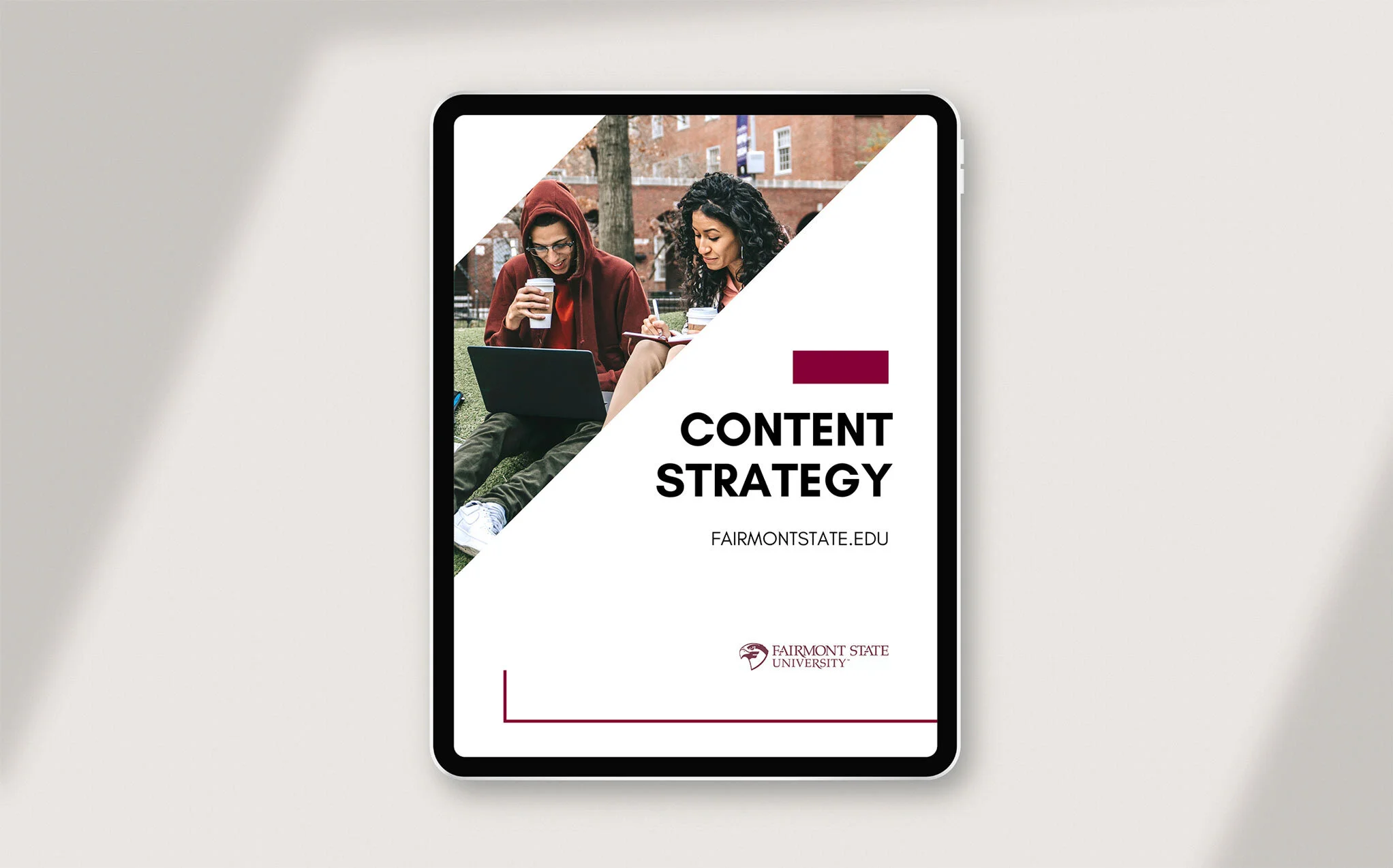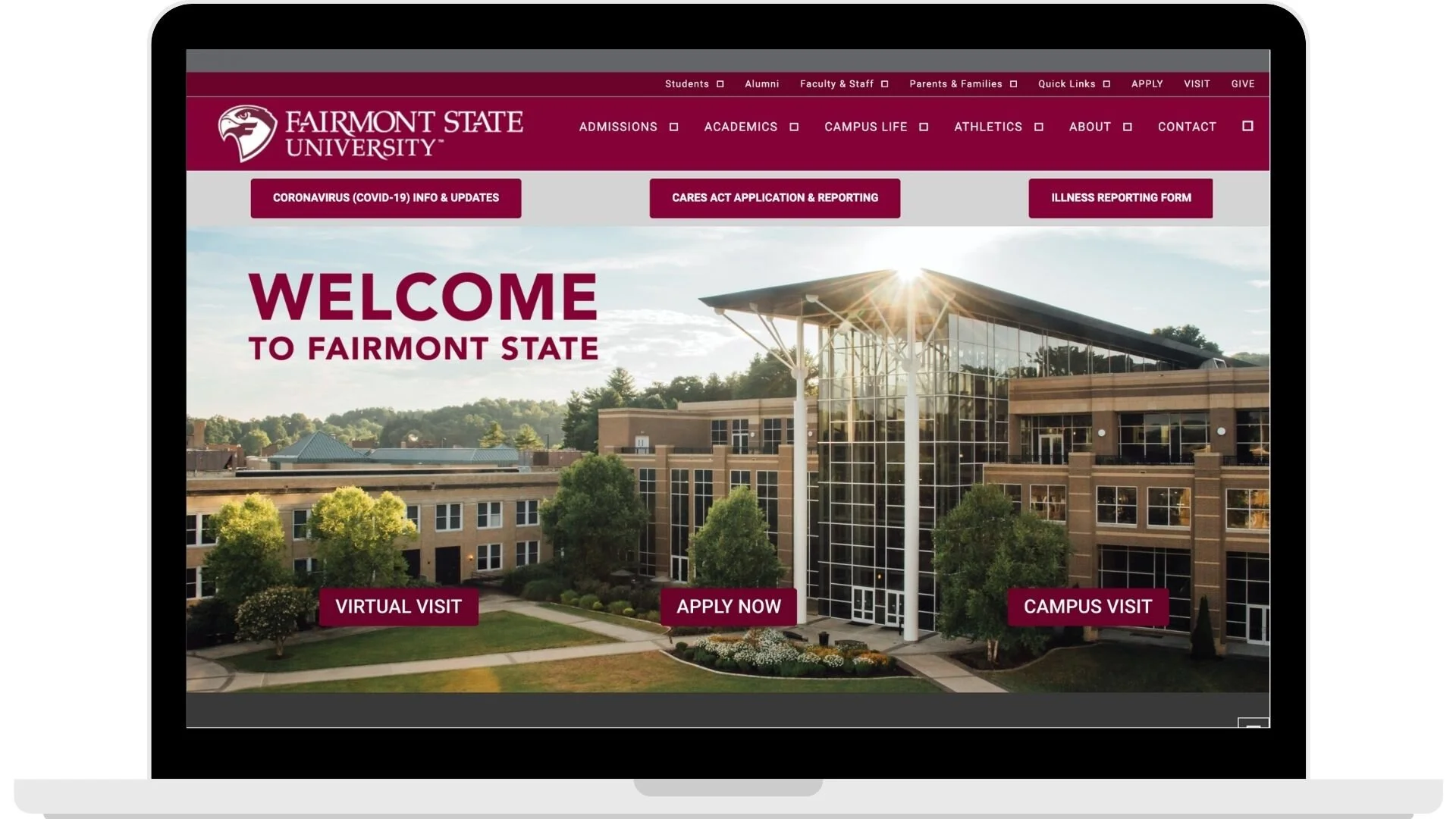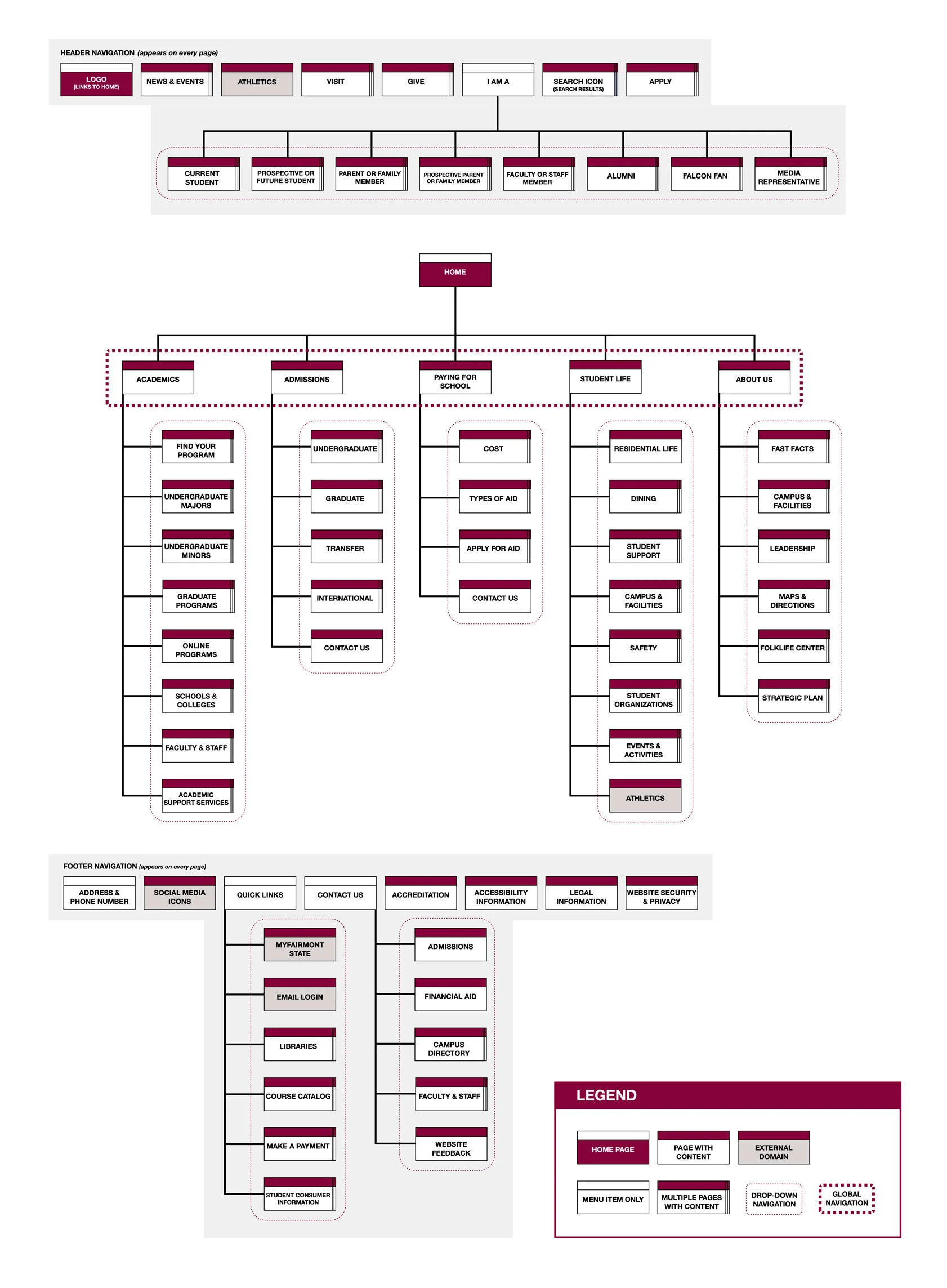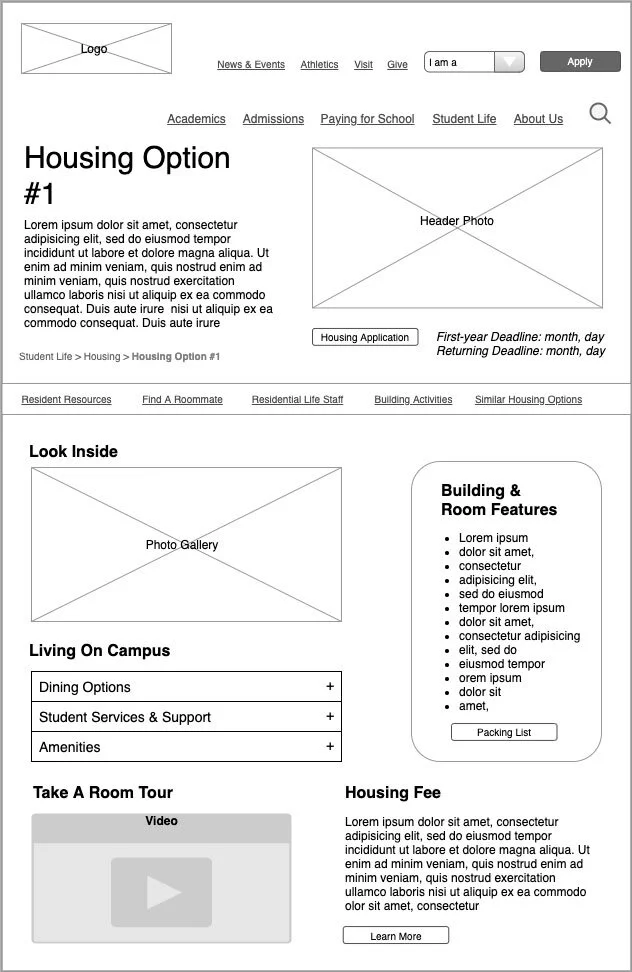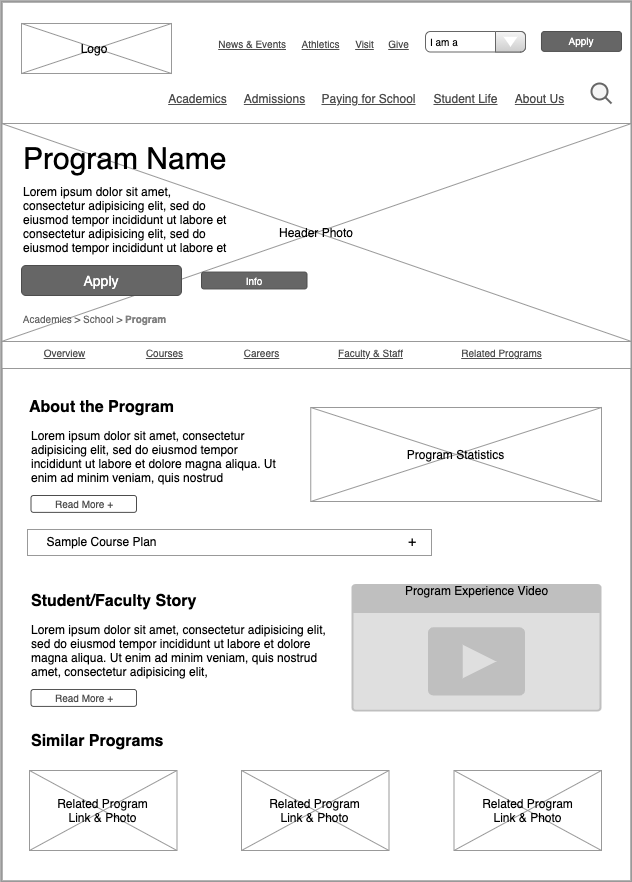Fairmont State Content Strategy
A website content strategy to support the student journey and increase enrollment at a small, public university.
Objective
With experience in higher education, I know that a great website is important for the admissions process and the student experience. When Fairmont State University (FSU), a public university in West Virginia, decided to redesign their flagship website to increase enrollment in a competitive higher education landscape their RFP focused on functionality and usability, but with little attention to content.
I decided to create a content strategy for a redesigned fairmontstate.edu to identify how better content could also help meet their goal.
Business Goals
I started by identifying the specific business goals related to increasing enrollment that content could impact:
Increase the number of students who apply to FSU
Increase the percentage of admitted students who enroll
Improve retention of current students
For each of these business goals, I also developed content objectives to support them.
Goal 1: Increase the number of students who apply to FSU
Connect prospective students to degree programs of most interest
Clearly communicate the application and financial aid process
Goal 2: Increase the percentage of admitted students who enroll
Demonstrate the value of an FSU education
Share about the student experience and community
Goal 3: Improve retention of current students
Connect students with the resources they need to stay engaged and succeed
Help students and their families easily navigate the college experience from first day to commencement
About the Users
While FSU’s website has many user groups, my strategy was created to focus on user groups most related to the 3 business goals I defined. I identified these to be:
User Groups
Parents, Families, Loved Ones of Prospective Students
Parents, Families, Loved Ones of Admitted Students
Parents, Families, Loved Ones of Current Students
Prospective Students
Admitted Students
Current Students
User Goals
Using my previously gained insights about higher education users, I identified the following user goals as being the most important for this strategy:
Explore academic programs and degrees the university offers
Find out admissions requirements, deadlines, and process
Learn how much FSU will cost, how to apply for financial aid, and pay bills
See what campus life is like, including facilities, residential life, and student services
Find courses, degree requirements, and academic support resources
Learn about campus events, organizations, and programming
Content Audit & Analysis
I began by examining FSU’s current site and content. This included focusing on architecture, writing, social media, and search engine optimization and accessibility using Screaming Frog’s SEO Spider application.
From this audit, I found that current content does not align with business goals or the goals of the primary user groups that I’d identified for the strategy. In general, the FSU site content was utilitarian, lackluster, and even inaccessible in some cases.
Findings
Issues I identified included:
Content is mostly utilitarian text with few images or media
Pages are not formatted well or consistently
There is no consistent voice or writing style
There is no central location to find news or events
SEO page titles and descriptions are mostly missing
Images and videos are not ADA accessible
Site is not fully responsive and load speed is extremely slow
There is no internal site search function
Recommendations
I found that content on the website needs a significant overhaul and should not be transferred as is onto the redesigned site as it is more a hurdle than a help for increasing applications, enrollment, and retention in its existing form. To better align content with business and user I goals, I developed a list of recommendations, including:
Focus more on storytelling and the people of FSU
Show, don't tell
Leverage social media and quality user-generated content
Help users find and focus on the content they need and want quickly
Strategy
To offer a memorable guiding light for the implementation of the content strategy I created a core strategy statement. I also created a messaging framework to explain what the desired first reaction to content is and what content should strive to prove to users about the university.
Core Strategy Statement
“To increase enrollment we will provide informative, inspiring, and approachable content that helps students and their families feel certain about choosing FSU and supported from their first visit through commencement and beyond.”
Messaging Framework
First Impression: "This seems like the right place for me."
Value Statement: "I feel empowered because I can find and understand information that helps me take action."
Proof: "They get what someone like me needs in order to successfully pursue a degree."
Design
I began design work by doing a competitive analysis of 3 fellow West Virginia universities' websites to identify opportunities for FSU. Specifically, I looked at:
Global navigation categories
How news and events were incorporated
Whether statistics or rankings were part of content and how they were displayed
If student quotes were used
How users discovered program offerings
If different user groups could self-identify to get audience-specific content
If content offered direction on next steps for users to complete tasks.
Using insights from both my content analysis and competitive analysis, I developed a preliminary site map. This information architecture was designed to be fairly standard and predictive for users who will likely have visited many other higher ed sites and help them quickly find information related to the primary user goals I’d identified.
To create preliminary page wireframes I began by outlining in a prioritization table what information users and the university would find important for each of 5 key user scenarios in the admission and student experience. From here, I connected what core pages would help to support which business goals and the content that users and the university would need to be on each of these pages to find them helpful.
I then used these content lists to ensure my wireframes were on strategy and accounted for all relevant content.
Writing Style
The brand’s identity is described as empowering, limitless, responsive, hardworking, genuine, and welcoming, so I developed writing style recommendations to reflect these traits, as well as offer a better experience for first-generation users.
Writing on the FSU site should be
Warm and helpful
Action- and goal-oriented
Use clear, concise, and as simple as possible language
Explain or define things like acronyms or university-specific language
Have a reading level of no higher than high school
Feature clearly labeled headings and sections, short sentences, short paragraphs, and bulleted lists
KPIs
Because goals don’t matter unless you have a way to measure success, I identified 3 key performance indicators (KPIs) to use to determine if the strategy is working or needs adjustment after implementation. The KPIs were:
Number of site interactions between admissions and users
Click-through rate for admitted students communications
Top reasons students leave FSU and traffic to pages with related content
Next Steps
To implement and maintain my strategy, FSU would need to make a number of decisions and define content guidelines, including:
Choosing a content management model to follow
Assigning content-related roles and responsibilities
Creating and maintaining content authority
Defining workflow for content creation
Doing a content inventory on the current site
Choosing a specific writing style guide to follow
Creating a shareable writing style guide for distribution
Establishing an editorial calendar

